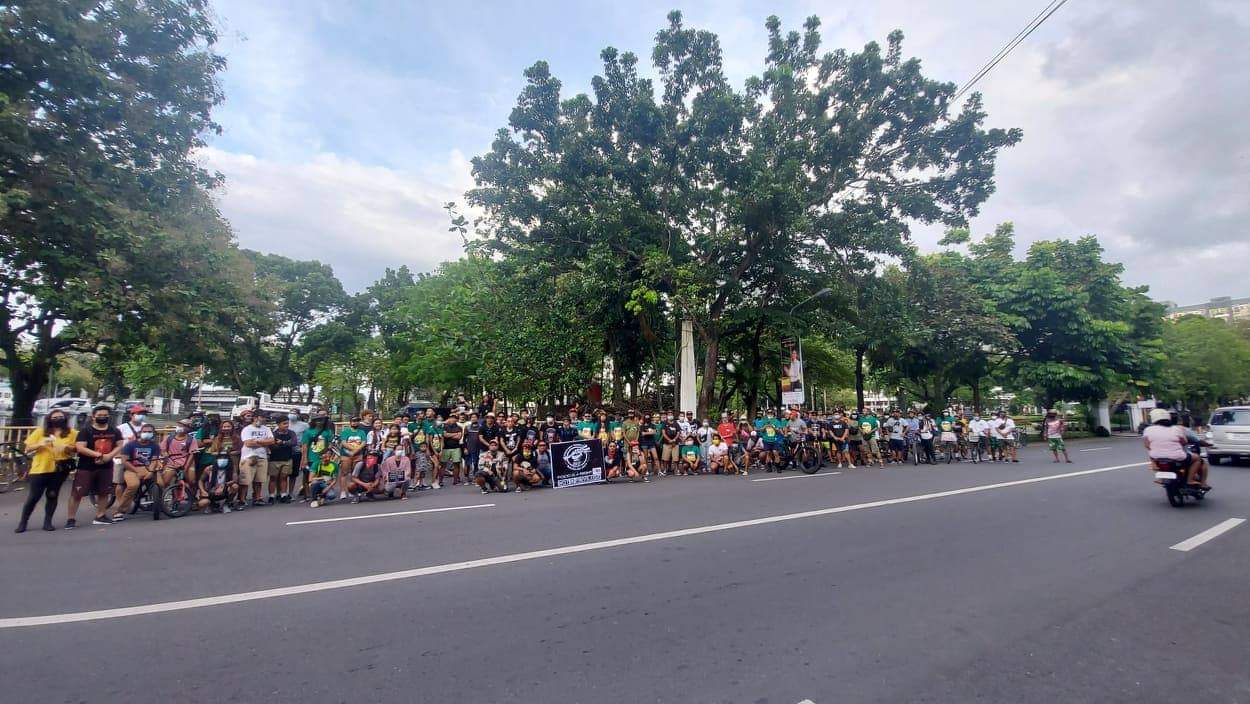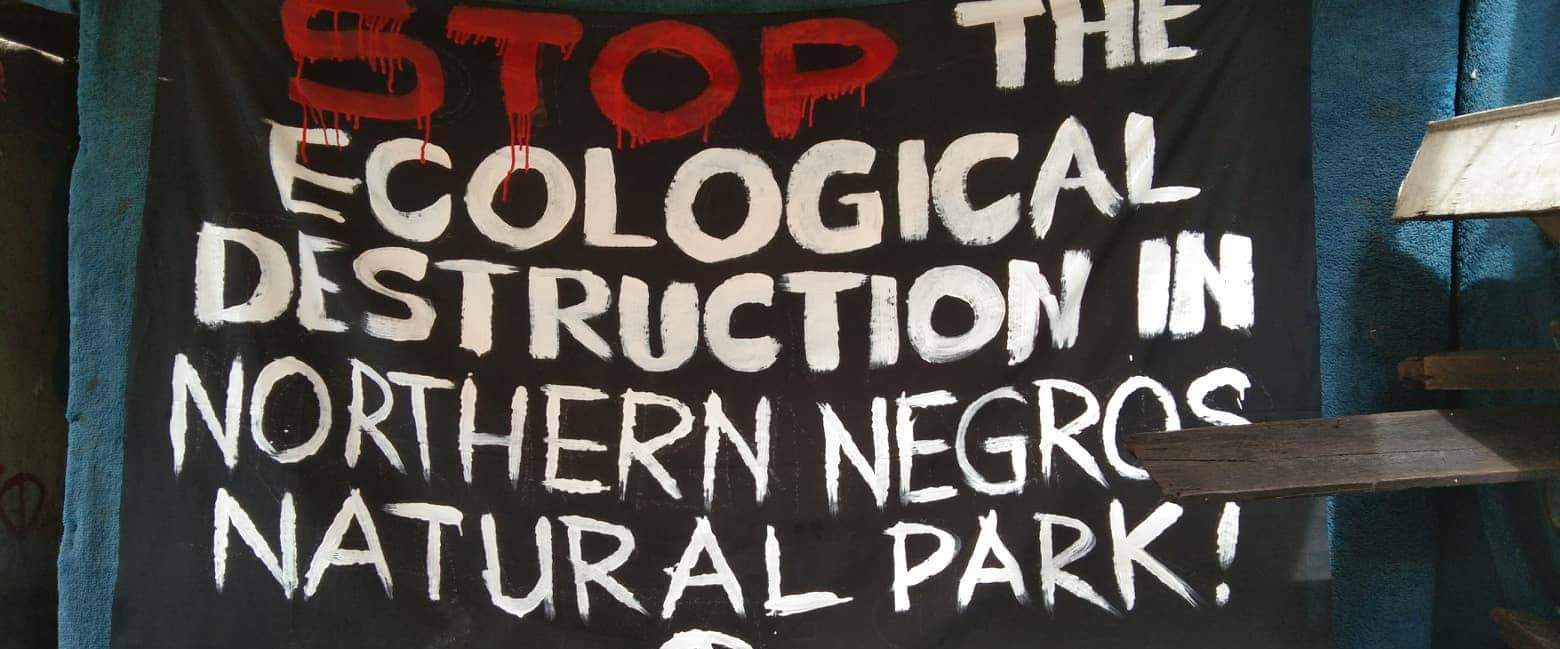This article is based on communication from a comrade in the Negros province of the Philippines. There is ongoing destruction of the natural world in this area due to road construction, a planned airport, and clearing of the rainforest. The people on the front lines, being most affected, are calling for international solidarity and support.
On October the 18th this year, the first direct action regarding the Northern Negros National Park was taken by a group of concerned people. Food Not Bombs Bacolod Volunteers and concerned citizens have started a campaign to raise awareness about the ongoing destruction of the rainforest in the Negros area of the Philippines. The group has begun disseminating information to ensure other know about the ongoing harm being caused and to stand firmly IN SOLIDARITY WITH THE FOREST.
The group, focused their work in the city of Bacolod distributing printed placards, information flyers & leaflets and have been clear they are in direct opposition to any act of destruction. Food Not Bombs Bacolod condemns these injustices and the actions of the Local Government of Negros Island which sanctions the destruction of the remaining rainforest of the island.
About Northern Negros National Park

A seasonally flooded caldera in Northern Negros National Park. Photo by Androkoy, Creative Commons Attribution-Share Alike 4.0 International.
The Northern Negros Natural Park is a protected area of the Philippines located in the northern mountainous forest region of the island of Negros in the Visayas. It is spread over five municipalities and six cities in the province of Negros Occidental and is the province’s largest watershed and water source for seventeen municipalities and cities including the Bacolod metropolitan area.
The park belongs to the Negros–Panay Biogeographic Region. It is one of two remaining lowland forests on Negros island, the other being in the Dumaguete watershed area in Mount Talinis on the southern end of the island in Negros Oriental.
The park is a habitat to important fauna including the Visayan spotted deer, Visayan warty pig, Philippine naked-backed fruit bat, and the endangered Negros shrew.
Number of endemic and threatened species of birds have been documented in the park, which includes the Visayan hornbill, Negros bleeding-heart, white-winged cuckooshrike, flame-templed babbler, white-throated jungle flycatcher, Visayan flowerpecker and green-faced parrotfinch.
Flora documented within the park include hardwood tree species (Dipterocarps), as well as palms, orchids, herbs and trees with medicinal value. Very rare is the local species of the cycas tree (locally called pitogo), probably a Cycas vespertilio, considered living fossil from the times of dinosaurs. Another prehistoric flora is present in the park like the tree ferns and the also protected Agathis philippinensis, (locally known as almaciga).
While We Were Distracted
As we know during 2020 most nations have been preoccupied trying to survive lockdown. During this time the local government of Negros Island, Protection And Management Board, Department of Environment and Natural Resources (DENR) failed in its responsibilities to protect the remaining watershed and rainforest. Road construction on the island started in the midst of Global Pandemic.
Instead the DENR legitimized the road construction on the Island and in doing so has increased the likelihood of communities on the island being destroyed in the medium to long term. The DENR, along with the Department of Public Works and the Department of Highways have acted in a way that swept aside the needs of local communities, that ignored the rights of the natural world and in doing so have colluded to strengthen their power. In short they have become the mechanism and tool of destruction for the island.
The Aerotroplis Project
The plans to build a new International Airport in Manila has also hit the radar of environmental activists. The people and environmental groups in Bulakan and Bulacan have shared concerns about the devastation this will cause to the natural world, to wildlife (including fish) populations, bird populations, air pollution, and airplanes flying in the sky. As always the focus is on economic benefits rather than the health of planet or people. There has been little or no analysis of the environmental impact.
Leon Dulce, national coordinator of Kalikasan-People’s Network for the Environment (Kalikasan-PNE), told the BusinessMirror that the presence of the bird populations are bioindicators of good ecological health. He stated “This is of crucial importance in these times when there are multiple epidemiological risks from pandemics, socioeconomic loss, and climate emergency all emerging from the disrupted environment. Massive land-reclamation activities in Manila Bay threatens the last remaining wetlands where migratory birds roost. The Bulacan Aerotropolis is one of the biggest threats that will destroy 2,500 hectares of mangroves and fisheries. It is outrageous that transportation mega infrastructure is being touted for economic recovery when global transportation is expected to remain disrupted until 2021.”
Critical Mass Ride
 Following the actions from Food Not Bombs Bacolad, on November 8th Local Autonomous Networks held a discussion to consider the ongoing problem. They agreed to organize a coordinated Critical Mass Ride. The ride involved concerned people in the Archipelago from the different islands of the Philippines gathering to travel around the main city to raise awareness.
Following the actions from Food Not Bombs Bacolad, on November 8th Local Autonomous Networks held a discussion to consider the ongoing problem. They agreed to organize a coordinated Critical Mass Ride. The ride involved concerned people in the Archipelago from the different islands of the Philippines gathering to travel around the main city to raise awareness.
Food Not Bombs and Local Autonomous Networks have issued a call to action to support them in opposing the road construction and the subsequent destruction of the Rainforest that will kill the livelihood of hundreds of families.
The call to action in the Archipelago is just a start. They have been clear they will not stop nor be silenced until the destruction planned has been stopped. They are calling for International Solidarity to all readers.
Join The Resistance. Join The Fight!
Save the Remaining Forest & Watershed of Northern Negros Natural Park, Stop the Patag-Silay-Calatrava-Cadiz Road Construction. STOP the Bulacan Aerotropolis Project.

